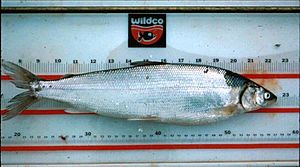Arctic cisco facts for kids
Quick facts for kids Arctic cisco |
|
|---|---|
 |
|
| Conservation status | |
| Scientific classification |
The Arctic cisco (Coregonus autumnalis) is a type of freshwater whitefish. It lives in the cold, northern parts of the world. You can find it in the Arctic regions of Siberia, Alaska, and Canada. This fish is special because it's an anadromous species. This means it lives mostly in the ocean but travels to fresh water to lay its eggs. It has a close relative called the pollan that lives in some lakes in Ireland.
Contents
About the Arctic Cisco
Scientists group living things together based on how they are related. The Arctic cisco is part of the Coregonus family. For a long time, people thought a fish called the omul from Lake Baikal was a type of Arctic cisco. But now, scientists know that the omul is actually a different species. It is called Coregonus migratorius.
What Does It Look Like?
The Arctic cisco has a fairly small head. Its snout, or nose area, does not stick out much. Its body is a shiny metallic silver color. The back of the fish is usually brown or dark green. Its fins are almost clear.
This fish does not have any spots. It also does not have teeth on its jaws. However, it does have a small patch of teeth on its tongue. Arctic cisco can grow up to 50 centimeters (20 inches) long. They can weigh up to 2 kilograms (4.4 pounds). Most of the time, they are smaller, less than 40 centimeters (16 inches) long. They usually weigh less than 1 kilogram (2.2 pounds).
Where Do They Live?
Arctic cisco live in the cold waters of the Arctic. You can find them in the Beaufort Sea. They also live in river deltas like the Colville River delta in Alaska. They are found in freshwater rivers east of the Sagavanirktok River.
These fish also live in several rivers in the Northwest Territories of Canada. They are found in Siberia, for example, in the Chaun River. They are not often found east of Point Barrow in Alaska.
Arctic Cisco's Place in the Food Chain
Every animal has a role in its environment. This includes what it eats and what eats it.
What Do They Eat?
The Arctic cisco is a predator, meaning it hunts for its food. Its diet includes:
- Tiny living things called plankton
- Small crustaceans, like shrimp
- Other small fish
What Eats Them?
The Arctic cisco is also prey for other animals. Its predators include:
- Large ocean mammals
- Seabirds
- Big fish, such as the Dolly Varden trout and burbot
How Arctic Cisco Live
The Arctic cisco has interesting behaviors, especially when it comes to having babies and traveling.
How Do They Reproduce?
Arctic cisco can start having babies when they are 8 or 9 years old. Female fish might only lay eggs two or three times in their whole life. They do not necessarily lay eggs every single year.
These fish reproduce in September. They do not lay their eggs in Alaskan waters. Instead, they travel to the Mackenzie River in Canada to reproduce. A female Arctic cisco can lay up to 90,000 eggs at one time!
How Do They Travel?
Young Arctic cisco travel along the coast of the Beaufort Sea. Winds help them get to the Colville River delta. This delta is more than 160 kilometers (100 miles) from where they were born. When it's time to lay their own eggs, they return to the Mackenzie River. They do not eat while they are swimming upstream to reproduce.
How Long Do They Live?
Arctic cisco can live for a long time. Some have been known to live for 13 years or even longer.
Protecting the Arctic Cisco
Scientists do not know much about how many Arctic cisco live in Alaska. This makes it harder to protect them.
What Threats Do They Face?
The biggest dangers to the Arctic cisco are:
- Climate change: Changes in the Earth's climate can affect their habitats.
- Oil and gas development: Activities related to finding and using oil and gas can harm their environment.
See also
 In Spanish: Cisco del Ártico para niños
In Spanish: Cisco del Ártico para niños


